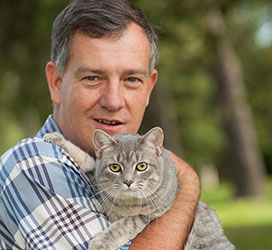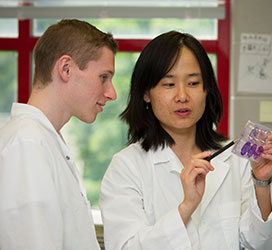Spotlight: Faculty member John S.L. Parker works to understand a common feline virus

Dr. John Parker, BVMS, Ph.D., is working on a puzzle. Feline calicivirus has a range of different effects in cats: temporary and mild flu-like symptoms in most, more chronic mouth and throat symptoms in others, and, in rare cases, severe life-threatening disease throughout the body.
Parker, a faculty member at the Baker Institute, is trying to determine why the virus has such variable effects, work that promises not only to help cats but might also eventually lead to treatments or vaccines for a familiar human disease: stomach flu.
As part of a large family of viruses called Caliciviridae, feline calicivirus is related to human norovirus, a pathogen perhaps best known for causing well-publicized outbreaks of gastroenteritis on cruise ships. Parker says that studies of the feline virus can inform studies of norovirus, a notoriously difficult pathogen to study in the lab.
Their common features highlight the importance of One Health in managing diseases: what scientists learn about animal diseases can have direct impact on knowledge of human diseases. Developing effective treatments for one disease can build the foundation for treatments for other related diseases.

The idea of One Health would not be difficult to explain to a virus, many of which exploit the connections between human health, animal health, and the environment to meet new hosts. Feline calicivirus and norovirus may have different hosts and cause different types of disease, but they share a great deal in common at the molecular level. “The structures of the two viruses are very similar,” said Parker, so the process of infection should be similar.
Solving the puzzle
Parker is searching for possible explanations for why some cats with feline calicivirus experience short-term flu-like symptoms while others develop a chronic mouth condition in which their gums grow thick and inflamed, making it painful to eat. He is focusing on how the virus first binds to cells and gets inside. Parker and his postdoctoral researcher, Dr. Zhengchun Lu have sequenced the genomes of 25 cats. They are examining genes responsible for creating receptor proteins on the outsides of cells to see if differences in these receptors might play a role in how the virus attaches and infects different cats.
In another project, Parker is detailing how the shape of the virus changes when attaching to receptors during infection. By defining these shapes, it may be possible to design a vaccine to target the virus during this vulnerable moment, preventing infection before it starts.
“By understanding those steps you can identify places in the process where you can block it,” said Parker.
Basic science like that which Parker conducts lays the foundation for One Health work, establishing facts about viruses and diseases and outlining connections between different species so that efforts to curb disease and improve animal and human health can be more effective. His work to define how calicivirus binds to cells may lead to drugs and vaccines for feline calicivirus, and those strategies could eventually be carried over to treat and prevent infection with norovirus or other pathogens.
“Discovery is never planned,” said Parker. “I try and make sure our lab has the freedom to pursue intellectual curiosity.”
This article first appeared in Scopes, the quarterly magazine of the Cornell University College of Veterinary Medicine.


